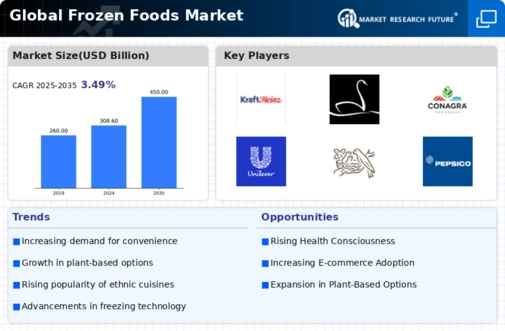Top Industry Leaders in the Frozen Foods Market

The frozen foods market has witnessed substantial growth and evolution over recent years, fueled by changing consumer lifestyles and an increasing demand for convenient and ready-to-eat options. The competitive landscape of the market is characterized by a diverse array of key players, each implementing specific strategies to gain a competitive advantage and expand their market share.
Key Players:
- General Mills (USA)
- Tyson Foods Inc (USA)
- Grupo Bimbo (Mexico)
- Conagra Brands Inc (USA)
- Associated British Foods Plc (UK)
- Nestle S.A. (Switzerland)
- Unilever Plc. (UK)
- Ajinomoto Company (Japan)
- Kraft Heinz Company (USA)
- McCain Foods Limited (Canada).
Strategies Adopted:
Product Innovation:
Key players in the frozen foods market prioritize product innovation to meet changing consumer preferences. This includes the introduction of healthier options, ethnic cuisines, and premium frozen meals to attract a diverse customer base.
Strategic Collaborations:
Collaborations and partnerships with retailers and foodservice providers are integral strategies. These alliances help companies expand their distribution networks, ensuring wider product availability and increased market reach.
Cost Optimization:
Amidst market competition, cost optimization is a key strategy for companies. Efficient supply chain management and production processes help maintain competitive pricing while ensuring product quality.
Brand Marketing:
Robust marketing and brand-building activities are crucial in the frozen foods sector. Companies invest significantly in advertising campaigns, social media presence, and promotions to enhance brand visibility and consumer loyalty.
Factors for Market Share Analysis:
Distribution Efficiency:
The efficiency of a company's distribution network plays a vital role in determining market share. Those with streamlined and well-managed distribution channels can effectively reach a larger consumer base.
Quality Standards:
Adherence to stringent quality standards is imperative for maintaining market share. Consumers tend to favor products from companies known for their commitment to quality and safety.
Brand Recognition:
Strong brand recognition is a significant factor contributing to market share. Established brands often enjoy a competitive advantage, as consumers are more likely to trust well-known names.
Adaptability to Consumer Trends:
Companies that can swiftly adapt to changing consumer trends, such as the demand for healthier or plant-based options, have a competitive edge. This adaptability ensures sustained relevance in the market.
New and Emerging Companies:
The frozen foods market has seen the entry of new and emerging companies looking to carve a niche for themselves. These companies often focus on specific market segments or introduce unique product offerings to differentiate themselves from established players. While some concentrate on organic and natural ingredients, others prioritize sustainable and ethical sourcing practices.
Industry News and Current Company Investment Trends:
Recent industry developments highlight a growing emphasis on sustainability and health-conscious consumer preferences. Key players are increasingly investing in eco-friendly packaging solutions and promoting transparency in ingredient sourcing. Additionally, there is a notable trend toward the development of frozen foods with cleaner labels, free from artificial additives.
In terms of investment trends, companies are directing resources towards digital marketing and e-commerce platforms. The surge in online grocery shopping has prompted frozen food manufacturers to optimize their online presence and enhance the consumer's digital shopping experience.
Overall Competitive Scenario:
The competitive scenario in the frozen foods market is intense, driven by the need to meet evolving consumer demands and stay ahead of industry trends. The market dynamics are influenced by factors such as economic conditions, consumer preferences, and regulatory developments. Established players leverage their brand equity and distribution networks, while new entrants strive to disrupt the market with innovative offerings.
Recent Development
The frozen foods market witnessed several noteworthy developments. Conagra Brands announced a strategic partnership with a leading e-commerce platform to enhance its online sales channels. This move reflects the company's commitment to meeting the changing purchasing preferences of consumers and expanding its digital footprint.
McCain Foods introduced a line of premium frozen appetizers, capitalizing on the growing demand for indulgent and high-quality frozen snacks. This product innovation aligns with consumer preferences for restaurant-quality frozen options at home.
General Mills, recognizing the importance of health-conscious choices, reformulated several of its frozen meals to include cleaner ingredients and reduced sodium content. This strategic move aims to appeal to the growing segment of consumers seeking healthier frozen food alternatives.
Unilever, in response to sustainability concerns, announced a comprehensive plan to reduce its carbon footprint across its frozen food supply chain. This initiative aligns with the increasing consumer demand for environmentally responsible practices from food manufacturers.
These recent developments underscore the dynamic nature of the frozen foods market, where companies continually adapt to changing market conditions and consumer expectations. As the industry progresses, strategic innovations and a keen understanding of consumer preferences will remain pivotal for companies vying for a competitive edge in the frozen foods market.


